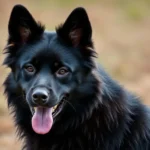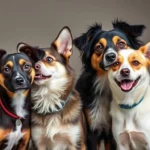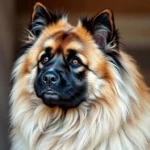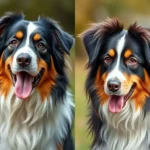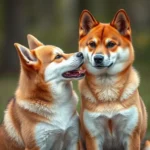
Introduction
Dog breeds refer to the various categories of dogs that have been selectively bred for specific traits, characteristics, and purposes. The classification of dog breeds is essential for understanding the diversity within the canine world. From tiny toy breeds to large working dogs, each breed has its own unique set of traits and characteristics. This diversity allows prospective dog owners to select breeds that align with their lifestyles and preferences.
Understanding different dog breeds is crucial for responsible pet ownership. Knowledge of a breed’s temperament, care requirements, and potential health issues can significantly impact the decision-making process for potential dog owners. In this article, we will delve into the Griffonshire, a charming mixed breed that has captured the hearts of many dog lovers.
Overview of Dog Breeds
Classification of Dog Breeds
Dog breeds can be classified into two main categories: purebred and mixed breed. Purebred dogs are those whose lineage can be traced back to a specific breed standard, while mixed breeds consist of two or more different breeds. Mixed breeds, like the Griffonshire, often inherit a blend of characteristics from their parent breeds.
Breeds are also categorized into various groups based on their intended functions. Common categories include:
- Working Dogs: Trained for specific tasks such as guarding, search and rescue, or pulling sleds.
- Sporting Dogs: Typically used for hunting and retrieving.
- Hound Dogs: Bred for hunting and tracking.
- Terriers: Energetic and feisty, originally bred for hunting vermin.
- Toy Breeds: Small and often bred for companionship.
- Non-Sporting Dogs: A diverse group that doesn’t fit neatly into other categories.
Factors Influencing Dog Breeds
The characteristics of dog breeds are influenced by genetics and breeding practices. Selective breeding has played a significant role in developing the distinct traits seen in various breeds. Additionally, the historical context of a breed often dictates its physical and behavioral characteristics, reflecting the tasks they were originally bred to perform.
The Griffonshire: A Unique Dog Breed
What is a Griffonshire?
The Griffonshire is a delightful mixed breed that results from crossing a Brussels Griffon and a Yorkshire Terrier. This breed combines the charming qualities of both parent breeds, making it a beloved choice for many dog owners. The Griffonshire is known for its affectionate nature and striking appearance.
Physical Characteristics
Griffonshires are small dogs, typically weighing between 7 to 12 pounds and standing around 8 to 12 inches tall at the shoulder. They have a well-proportioned body, with a distinctive face that inherits the Brussels Griffon’s expressive eyes and the Yorkshire Terrier’s elegant build.
Common coat types include:
- Smooth: Short and shiny, resembling the Yorkshire Terrier’s coat.
- Wiry: A bit longer and coarser like the Brussels Griffon.
Color variations can include black, tan, and a mix of these shades, often with unique markings that add to their charm.
Temperament and Behavior
The Griffonshire is known for its lively and affectionate personality. Typically, they are friendly, playful, and very sociable, making them great companions for families and individuals alike. They thrive on attention and love interacting with their human family members.
Socialization is crucial for the Griffonshire, as they can be wary of strangers. Proper exposure to different environments, people, and animals during their formative months helps them develop into well-rounded adults.
Care and Maintenance of Griffonshires
Grooming Needs
Grooming is essential for keeping a Griffonshire looking its best. Depending on the coat type, grooming frequency will vary:
- Wiry coats may require regular brushing to prevent matting and should be trimmed every few months.
- Smooth coats are easier to maintain, needing only occasional brushing.
It’s also important to regularly check and clean their ears, nails, and teeth to ensure overall health.
Dietary Requirements
A balanced diet is vital for the health of a Griffonshire. High-quality dog food, whether dry kibble or wet food, should be the foundation of their diet. Aim for food that lists real meat as the first ingredient and avoid fillers like corn and soy.
Portion control is important due to their small size. Typically, adult Griffonshires require about ½ to 1 cup of food daily, divided into two meals. Always consult with a veterinarian for specific dietary recommendations.
Exercise Needs
Despite their small size, Griffonshires are energetic dogs that require regular exercise. Daily walks, playtime, and mental stimulation are essential to keep them happy and healthy. Activities like fetch or agility games can be great fun for them.
Mental enrichment is equally important. Puzzle toys and training sessions can help keep their minds sharp and prevent boredom, which can lead to undesirable behaviors.
Health Considerations for Griffonshires
Common Health Issues
Like all breeds, Griffonshires can be prone to certain health issues. Potential health concerns include:
- Dental Problems: Small breeds often face dental issues, so regular dental care is crucial.
- Patellar Luxation: A common issue in small breeds, where the kneecap dislocates.
- Respiratory Issues: Due to their brachycephalic traits from the Brussels Griffon.
Regular veterinary check-ups and preventive care can help catch any potential issues early.
Lifespan Expectations
The average lifespan of a Griffonshire is typically between 12 to 15 years. Factors such as genetics, diet, exercise, and healthcare can significantly influence their longevity.
Health Insurance
Investing in pet insurance can be a smart choice for Griffonshire owners. Insurance can help cover unexpected medical expenses and provide peace of mind, allowing owners to focus on their pet’s well-being without financial stress.
Training and Socialization
Basic Training Needs
Training is essential for any dog, and Griffonshires are no exception. Early obedience training helps instill good manners and fosters a strong bond between the dog and owner. Positive reinforcement methods, such as treats and praise, work best with this breed.
Socialization Techniques
Socializing a Griffonshire is crucial for their development. Early exposure to various people, environments, and other animals helps minimize fear and anxiety. Activities like puppy classes, dog parks, and playdates can facilitate positive interactions.
Griffonshire in Popular Culture
Media Representation
While the Griffonshire may not be as widely recognized as some other breeds, its parent breeds have made notable appearances in films and television. The Brussels Griffon has been featured in movies like “As Good as It Gets,” showcasing its unique charm.
Celebrity Owners
Several celebrities have embraced the Griffonshire or its parent breeds, further popularizing their appeal. These endorsements often highlight the breed’s affectionate nature and suitability as companions.
Pros and Cons of Owning a Griffonshire
Advantages
Owning a Griffonshire comes with numerous advantages:
- Companionship: Their affectionate nature makes them excellent companions.
- Adaptability: They can thrive in various living situations, from apartments to houses with yards.
- Low Exercise Requirements: While they need daily exercise, their small size makes it manageable.
Challenges
There are also challenges to consider:
- Training Needs: They may require consistent training efforts due to their intelligent yet sometimes stubborn nature.
- Health Care Costs: Potential health issues may lead to increased vet bills.
- Attention Requirements: Their social nature means they thrive on interaction and can suffer from separation anxiety if left alone for long periods.
Conclusion
In summary, the Griffonshire is a delightful and affectionate mixed breed that embodies the best traits of its parent breeds. With their charming personality, they make wonderful companions for various lifestyles. Understanding the breed’s characteristics, care needs, and potential challenges is essential for prospective owners.
When considering adding a Griffonshire to your family, it’s vital to reflect on your lifestyle and commitments. Responsible pet ownership begins with education and understanding, ensuring a happy and fulfilling life for both you and your new furry friend.



